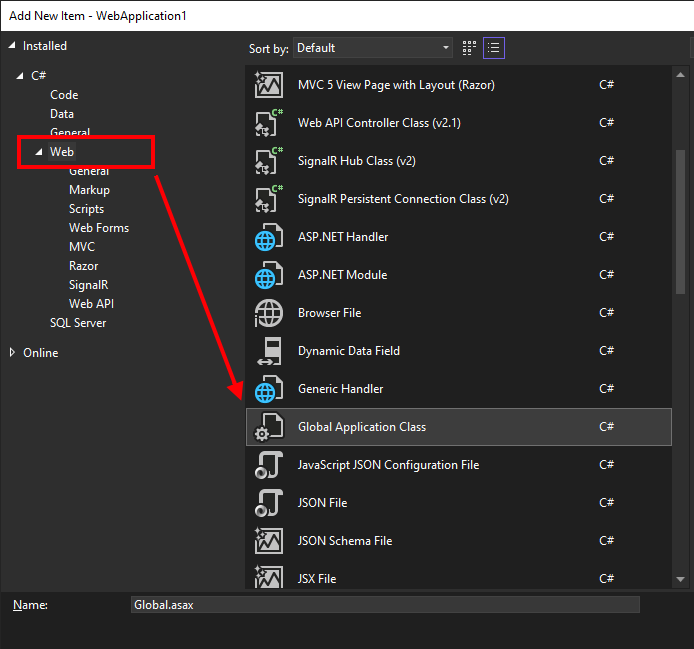View source code at: Github
Live Demo: http://autoroute.adriancs.com
Introduction
There are a few factors that affect the path of URL in ASP.NET.
In order to organize the pages, they are normally being grouped with folders.
Here is one of the typical URLs for a page.
/pages/admin/setup/user/v2/EditUser.aspxThe page “EditUser.aspx” located within the folder of “v2“, which falls in the folder “user“, which falls in the folder “setup“, which falls in another folder “admin“, which… again falls into yet another folder called “pages“.
As the project grows larger, more and more root folders will be scattered all over within the projects.
Since the folder path ties strictly to the path of URL of the file, it will make the URL become very long.
ASP.NET provides a useful function call “Routing” that can solve the long URL problem.
Here’s how it is implemented.
At the root of the project, add a “Global Application Class” file, so called “Global.asax“.

Open the file “Global.asax“.

Import the library of routing by adding a using statement:
using System.Web.Routing;At the method Application_Start( )
protected void Application_Start(object sender, EventArgs e)
{
}Type the routing code:
protected void Application_Start(object sender, EventArgs e)
{
RouteTable.Routes.MapPageRoute("EditUser", "EditUser",
"~/admin/setup/user/v2/EditUser.aspx");
}This will make the following URL:
/admin/setup/user/v2/EditUser.aspxshorten to:
/EditUserLooks good so far….
What if… there are a lots (yeah… a huge lots) of pages?
Well, ends up you are going to route them all one by one… for example:
RouteTable.Routes.MapPageRoute("UserEdit", "UserEdit",
"~/admin/setup/user/v2/UserEdit.aspx");
RouteTable.Routes.MapPageRoute("UserList", "UserList",
"~/admin/setup/user/v2/UserList.aspx");
RouteTable.Routes.MapPageRoute("UserCategory", "UserCategory",
"~/admin/setup/user/v2/UserCategory.aspx");
RouteTable.Routes.MapPageRoute("UserCategoryEdit", "UserCategoryEdit",
"~/admin/setup/user/v2/UserCategoryEdit.aspx");
RouteTable.Routes.MapPageRoute("InvoicePreview", "InvoicePreview",
"~/invoice/user/v3/InvoicePreview.aspx");
RouteTable.Routes.MapPageRoute("InvoiceSarch", "InvoiceSarch",
"~/invoice/user/v3/InvoiceSarch.aspx");
// ...
// continue for yet another lots of... lots of pages...
// ....And yeah, you get the idea. That would be a hell lot of lines. The huge lines of routing code will make the maintenance work painful. Bugs can be hard to be monitored.
But, how about… route all the pages automatically in a single line?
Here Is What We Are Going to Do
Use only one single root folder to organize all pages.
For example, instead of having multiple root folders like this:
/settings
/user
/activity
/invoice
/member
/inventory
.... Put them altogether in a single folder like this:
/pages/settings
/pages/user
/pages/activity
/pages/invoice
/pages/member
/pages/inventory Then, go back to the “Global.asax” file to code the routing commands.
At the Application_Start method, type the following routing command:
protected void Application_Start(object sender, EventArgs e)
{
RouteFolder("~/pages");
}Here’s the content of RouteFolder method:
public static void RouteFolder(string folder)
{
// Obtain the root directory path:
// example: D:\wwwroot\mywebsite\
string rootFolder = HttpContext.Current.Server.MapPath("~/");
// ensure the "folder" is prefixed with "~/"
if (folder.StartsWith("~/"))
{ }
else if (folder.StartsWith("/"))
{
folder = "~" + folder;
}
else
{
folder = "~/" + folder;
}
// obtain the physical folder path
// example: D:\wwwroot\mywebsite\pages\
folder = HttpContext.Current.Server.MapPath(folder);
// Start routing the in another separate method
MapPageRoute(folder, rootFolder);
}The MapPageRoute method. First obtain the sub-folders:
static void MapPageRoute(string folder, string rootFolder)
{
// obtain sub-folders within the 'folder' directory
string[] folders = Directory.GetDirectories(folder);
// loop through each sub-folder
foreach (var subFolder in folders)
{
// perform a recursive loop call on every sub-folder
MapPageRoute(subFolder, rootFolder);
}
// obtain all files within the 'folder' directory
string[] files = Directory.GetFiles(folder);
// loop through each file
foreach (var file in files)
{
// if the file is an asp.net web page, skip the file
if (!file.EndsWith(".aspx"))
continue;
// convert the file path into web-relative path
// example:
// input >> D:\wwwroot\mywebsite\pages\Member.aspx
// output >> ~/pages/Member.aspx
string webPath = file.Replace(rootFolder, "~/").Replace("\\", "/");
// extract the filename without the extension from the file path
// example:
// input >> D:\wwwroot\mywebsite\pages\Member.aspx
// output >> Member
var filename = Path.GetFileNameWithoutExtension(file);
// check if the file belons to default landing page
// this file usually existed multiple times within a website
if (filename.ToLower() == "default")
{
// skip routing for the default landing page
continue;
}
// finally, perform the routing mechanism
// example of input:
// filename = Member
// webPath = ~/pages/Member.aspx
RouteTable.Routes.MapPageRoute(filename, filename, webPath);
}
}
So now, instead of doing this:
protected void Application_Start(object sender, EventArgs e)
{
RouteTable.Routes.MapPageRoute("UserEdit", "UserEdit",
"~/pages/admin/setup/user/v2/UserEdit.aspx");
RouteTable.Routes.MapPageRoute("UserList", "UserList",
"~/pages/admin/setup/user/v2/UserList.aspx");
RouteTable.Routes.MapPageRoute("UserCategory", "UserCategory",
"~/pages/admin/setup/user/v2/UserCategory.aspx");
RouteTable.Routes.MapPageRoute("UserCategoryEdit", "UserCategoryEdit",
"~/pages/admin/setup/user/v2/UserCategoryEdit.aspx");
RouteTable.Routes.MapPageRoute("InvoicePreview", "InvoicePreview",
"~/pages/invoice/user/v3/InvoicePreview.aspx");
RouteTable.Routes.MapPageRoute("InvoiceSarch", "InvoiceSarch",
"~/pages/invoice/user/v3/InvoiceSarch.aspx");
// ....
// continue for yet another lots of... lots of pages...
//
}All you need is just one single line:
protected void Application_Start(object sender, EventArgs e)
{
RouteFolder("~/pages");
}and Voila! It’s done, like magic. All pages are routed without supervision (coding the route command 1 by 1).
All these pages with confusing, complicated URL path (due to organizing pages):
/pages/admin/setup/user/v2/EditUser.aspx
/pages/admin/system/settings/AppConfig.aspx
/pages/user/ViewUserProfile.aspx
/pages/activity/ActivityEventList.aspx
/pages/invoice/v3/PrintInvoice.aspx
/pages/member/group/EditMemberList.aspx
/pages/departments/inventory/setup/InventoryCategory.aspxwill now all shorten to:
/EditUser
/AppConfig
/ViewUserProfile
/ActivityEventList
/PrintInvoice
/EditMemberList
/InventoryCategoryYou just need to be careful not to repeat (re-use) the same filename in a different folder.
For example:
/pages/member/Search.aspx
/pages/team/Search.aspxInstead of this, put the section name within the filename, like this:
/pages/member/SearchMember.aspx
/pages/team/SearchTeam.aspxand the pages will be routed to as follow:
/SearchMember
/SearchTeamOkay, that’s all for this article.
Thanks for reading and happy coding.
